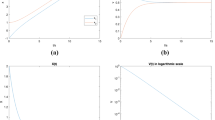Abstract
This paper analyzes the multi-cluster flocking behavior of a Cucker-Smale model involving delays and a short-range communication weight. In each sub-flocking group, the velocity between agents is alignment and the position locates at a limited domain; but in different sub-flocking groups, the position between agents is unbounded. By constructing dissipative differential inequalities of sub-ensembles together with Lyapunov functional methods, the authors provide the sufficient condition for the multi-cluster flocking emerging. The sufficient condition includes the estimation of the range of coupling strength and the upper bound of time delay. As a result, the authors show that the coupling strength among agents and initial threshold value determine the multi-cluster flocking behavior of the delayed Cucker-Smale model.
Similar content being viewed by others
References
Reynolds C, Flocks, herds and schools: A distributed behavioral model, Computer Graphics, 1987, 21(4): 25–34.
Vicsek T, Czirok A, Ben-Jacob E, et al., Novel type of phase transition in a system of self-driven particles, Physical Review Letters, 2006, 75(6): 1226–1229.
Cucker F and Smale S, Emergent behavior in flocks, IEEE Transactions on Automatic Control, 2007, 52(5): 852–862.
Cucker F and Smale S, On the mathematics of emergence, Japanese Journal of Mathematics, 2007, 2(1): 197–227.
Ha S Y and Liu J G, A simple proof of the Cucker-Smale flocking dynamics and mean-field limit, Communications in Mathematical Sciences, 2009, 7(2): 297–325.
Shen J, Cucker-Smale flocking under hierarchical leadership, SIAM Journal on Applied Mathematics, 2007, 68(3): 694–719.
Li Z C and Xue X P, Cucker-Smale flocking under rooted leadership with fixed and switching topologies, SIAM Journal on Applied Mathematics, 2010, 70(7): 3156–3174.
Dong J G and Qiu L, Flocking of the Cucker-Smale model on general digraphs, IEEE Transactions on Automatic Control, 2017, 62(10): 5234–5239.
Ru L N and Xue X P, Multi-cluster flocking behavior of the hierarchical Cucker-Smale model, Journal of the Franklin Institute, 2017, 354(5): 2371–2392.
Cho J, Ha S Y, and Huang F, Emergence of bi-cluster flocking for agent-based models with unit speed constraint, Analysis & Applications, 2016, 14(1): 39–73.
Cho J, Ha S Y, and Huang F, Emergence of bi-cluster flocking for the Cucker-Smale model, Mathematical Models and Methods in Applied Sciences, 2016, 26(6): 1191–1218.
Ha S Y, Ko D, and Zhang Y, Critical coupling strength of the Cucker-Smale model for flocking, Mathematical Models and Methods in Applied Sciences, 2017, 27(6): 1051–1087.
Liu Y C and Wu J H, Flocking and asymptotic velocity of the Cucker-Smale model with processing delay, Journal of Mathematical Analysis & Applications, 2014, 415(1): 53–61.
Young-Pil C and Jan H, Cucker-Smale model with normalized communication weights and time delay, Kinetic & Related Models, 2016, 10(4): 1011–1033.
Cristina P and Irene R V, Flocking estimates for the Cucker-Smale model with time lag and hierarchical leadership, Journal of Mathematical Analysis & Applications, 2017, 464(2): 1313–1332.
Erban R, HasKovec J, and Sun Y, A Cucker-Smale model with noise and delay, SIAM Journal on Applied Mathematics, 2015, 76(4): 1535–1557.
Young-Pil C and Li Z C, Emergent behavior of Cucker-Smale flocking particles with time delays, Applied Mathematics Letters, 2018, 86: 49–56.
Author information
Authors and Affiliations
Corresponding authors
Additional information
This research was supported by the National Natural Science Foundation of China under Grant Nos. 11671011 and 11428101.
This paper was recommended for publication by Editor YOU Keyou.
Rights and permissions
About this article
Cite this article
Qiao, Z., Liu, Y. & Wang, X. Multi-Cluster Flocking Behavior Analysis for a Delayed Cucker-Smale Model with Short-Range Communication Weight. J Syst Sci Complex 35, 137–158 (2022). https://doi.org/10.1007/s11424-021-0026-3
Received:
Revised:
Published:
Issue Date:
DOI: https://doi.org/10.1007/s11424-021-0026-3



